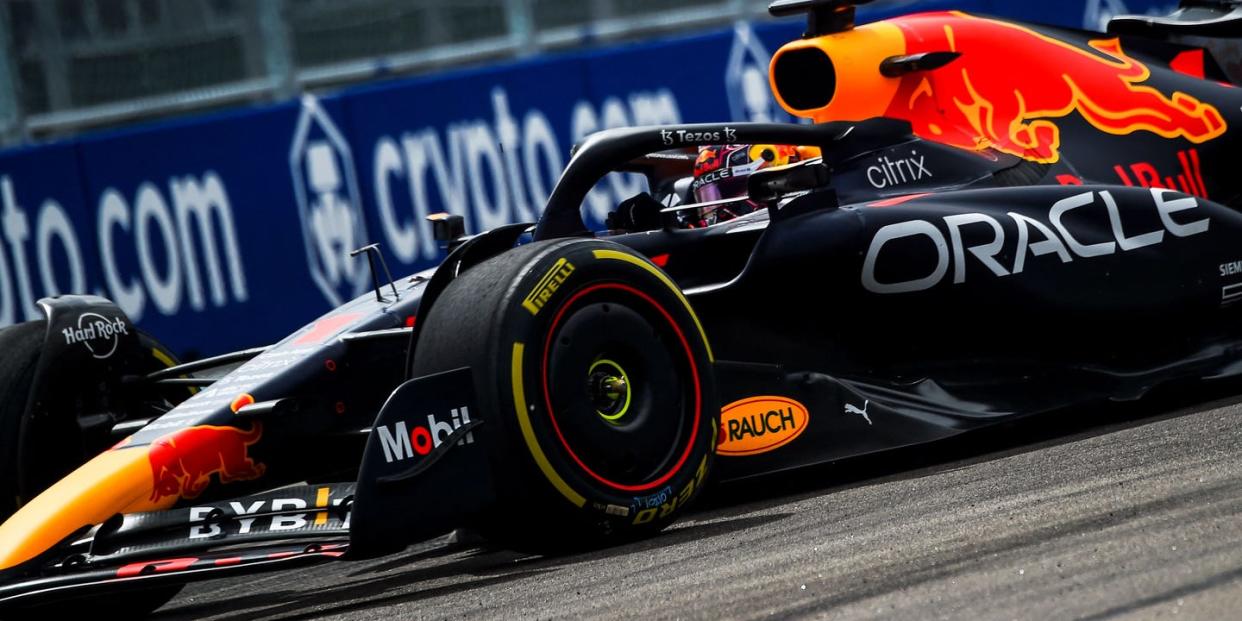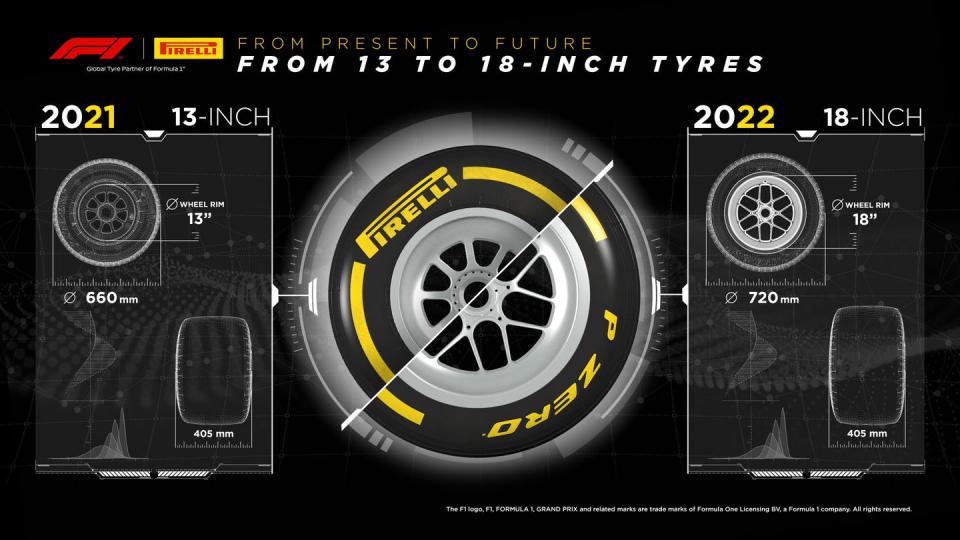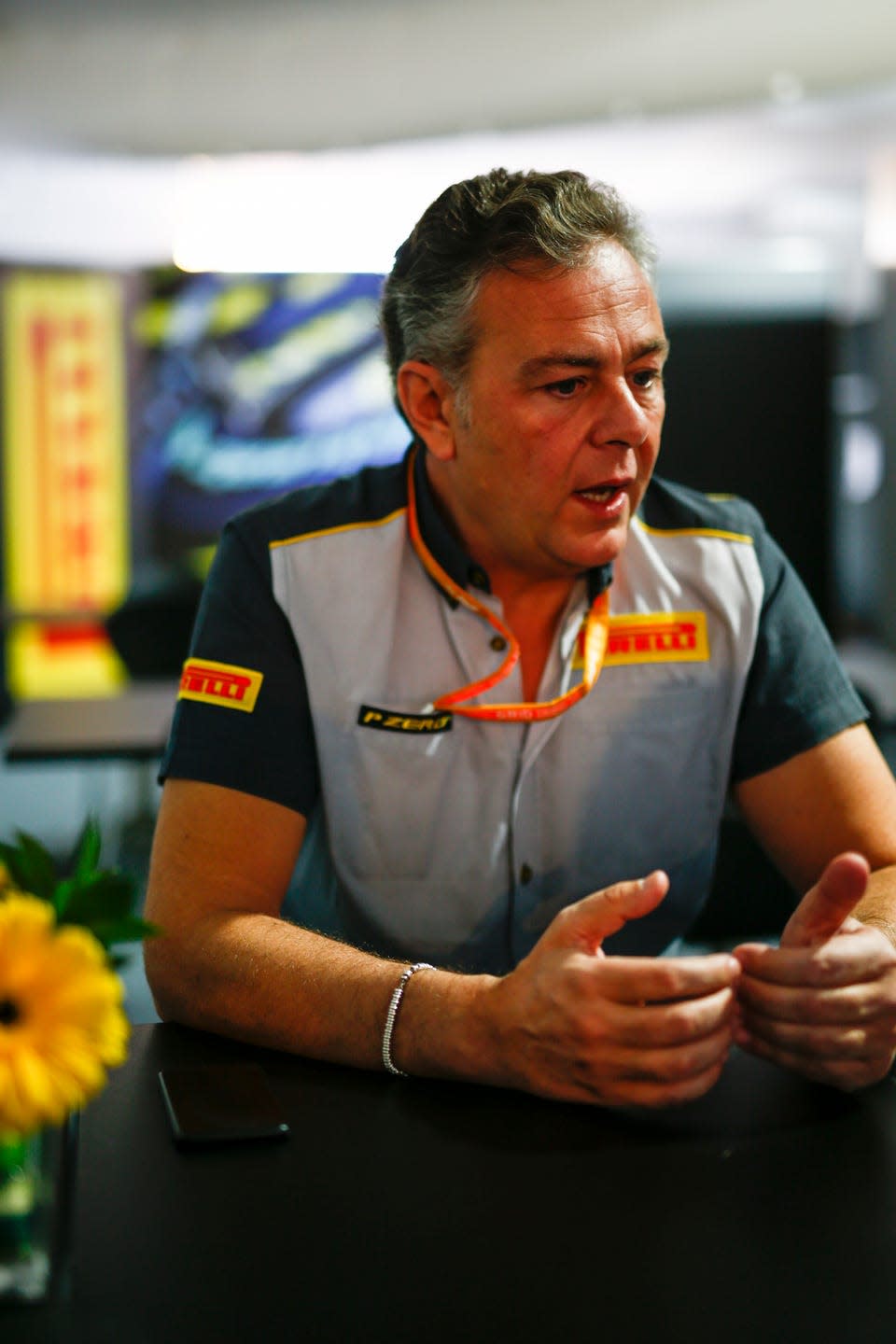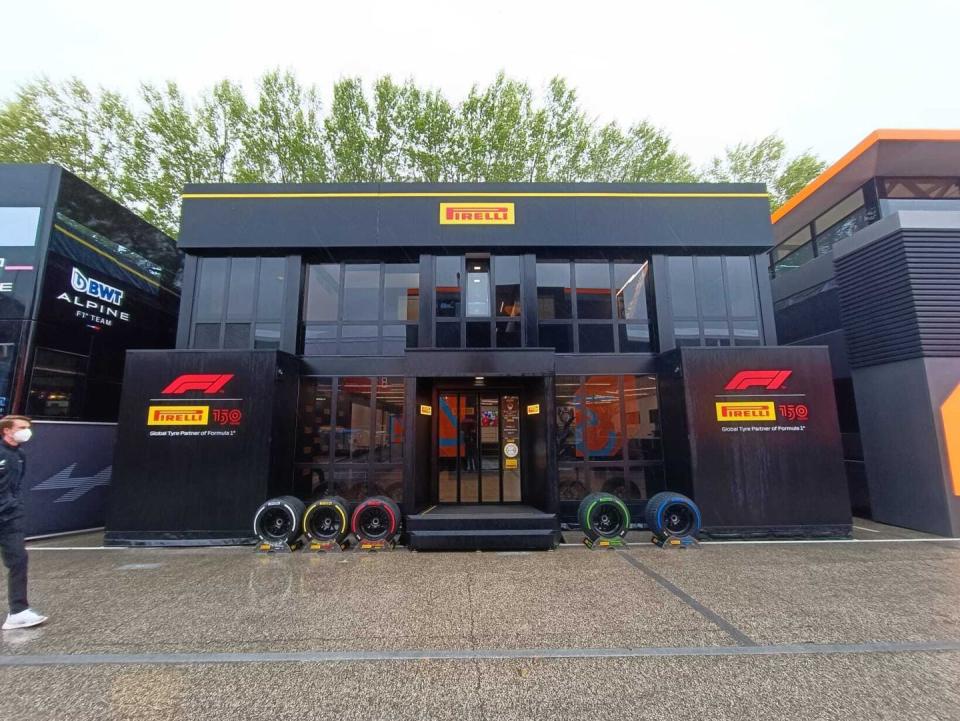How Move to 18-inch F1 Tires Makes Pirelli Even More Relevant

For the first time in nearly 60 years, the width of Formula 1 racing tires increased by 25 percent, going from 13 inches wide to 18 inches wide this season.
The new tires are also constructed of new compounds, giving not only a different size but also a completely different feel to the rubber makeup of each tire.
Pirelli celebrated its 150th anniversary earlier this year, with the company being originally founded in Milan, Italy, on January 28, 1872 by Giovanni Battista Pirelli.
Most of us give very little thought to tires on our personal cars. We typically buy whatever is on sale and move on.
Yet when it comes to Formula 1, tires are as important as the high-horsepower engines that power the race cars and the immense talent of the drivers behind the wheel. If you have bad tires, you typically will have a bad race.
But bad tires are a rare exception for Pirelli Tires, official tire for F1. This company has made development of racing tires practically an art form, with as many as six different types of racing rubber to be used in F1 events.

For the most recent F1 race, the debut event at Miami on May 8, officials from Pirelli gave Autoweek an in-depth tour of their at-track facility that monitors the roughly 1,600 tires the company brought to the track to be utilized by the 20 cars entered in the race.
There are five compounds, all color-coded: Hard (white), Medium (yellow) and soft (red), as well as two versions of rain tires, intermediate (green) and full wet (blue).
At each Grand Prix, each driver/car gets 13 sets of slicks (12 in races when there is the Sprint qualifying format) for dry pavement racing. That breaks down to two sets of hard, three of medium and eight of soft. For Sprint races, the allotment is two sets of hard tires, four of medium and six of soft compound.
In addition, each team has seven sets in reserve for wet conditions: four sets of intermediate and three sets of full wet tires, making for a grand total of 20 sets of tires per driver/car per race.
This season is a major campaign for Pirelli, which celebrated its 150th anniversary as a company earlier this year in January. For the first time in nearly 60 years, and due to F1’s radically changed race car, the width of racing tires increased by 25 percent, going from 13 inches wide to 18 inches wide.
In so doing, the new tires were specifically designed to be more precise when changing direction, ensure maximum consistency and less overheating than what was oftentimes seen with the 13-inch tires. In addition, the lower sidewall means less tire flex, which will have less impact upon overall aerodynamics of the car.
“All of which should favor close racing,” a Pirelli press release proudly states.

Autoweek had a chance to speak with Pirelli’s head of F1 operations, Mario Isola, who oversaw Pirelli’s return to F1 in 2011 after a 20-year absence away from the series.
“(Moving from 13 to 18 inches) is a plan that started a few years ago, in order to have a new Formula 1, or a more modern Formula 1,” Isola told Autoweek. “And the package is completely different, using the ground effect as a main mechanism to generate downforce. That is important because in the past, when they were following another car, they were losing up to 40% of downforce. That means that without downforce, you cannot get the performance and it was a lot more difficult to overtake. On top of that, you overheat the tire because you started sliding. So this double effect was while it was not impossible to overtake, it was quite difficult.
“So together with the new cars, there was a need to give a different look to these new cars with new tires, and the 18-inch tires is a lot more relevant for us. We use Formula 1 to transfer technology from race to road. So having now 18 inches is a lot better for us because we have also size that is comparable to what we use on road cars (cars that consumers drive on the streets).”
The switch from 13 to 18 inches began in 2019, with plans to introduce the new tire in 2021. But when the COVID-19 pandemic hit in mid-February 2020, it sidelined development of the new tire for nearly a year, forcing Pirelli to postpone release of its new tire until 2022, the same timeline for F1’s new chassis.
“Everybody started basically with simulations,” Isola said. “We made the first physical prototypes mid-2019 for the indoor testing to assess the level of integrity, and the first test was in September 2019. So we continued until February 2020. Then we had to stop (due to the pandemic) and then we started again in 2021 to finalize the product.

“The product is not just new because of the size, it’s new because of the characteristics: drivers want to push on tires, they want action on and they were asking us to have a wider working range for the compounds, reduce overheating, to reduce degradation—and that is what we did, we designed the tires with these ideas in mind.”
The new tires are also constructed of new compounds, giving not only a different size but also a completely different feel to the rubber makeup of each tire.
“The working range is conventional,” Isola said. “There is always a peak of somewhere at a certain temperature for each compound. You can design this curve in a way that you think this peak is a bit more flatter and wide. This is what we defined the work in.

“But at the end of the day, you always have a specific temperature range where the compound is giving you the maximum, and the teams are working there. Because when you have 10 cars, 12 cars within two tenths of a second, you need to find that is not the working range, you're not interested in the working range. That is the most difficult part of the job for them.
“And when you have a new tire, they have to learn how to use the new tire. This year, we decided to start with a complete new family of compounds because last year, drivers were complaining about overheating and so on. And we said okay, what should we do? We can start from the current family of compounds and develop or we can adopt a complete new idea, a new process with new ingredients and try to make a real step (up).
“We decided to take the risk because developing the old compounds for sure, we can find that a small step of improvement, but not the step that was required or what was needed. And the drivers felt that. But now they have to learn how to use them because the stuff is bigger, so the learning curve is bigger as well.”
In the process—and even though it was not designed this way, it just kind of evolved—competition has caused somewhat of a shakeup in performance by individual teams.
For example, teams that have done outstanding over the last several seasons—most notably Mercedes and seven-time F1 champ Lewis Hamilton, who has struggled in the first five races, entering this weekend’s race in Spain in a not-familiar ranking of sixth in the driver standings and with just one podium finish.
Conversely, teams that have struggled in recent years have seemingly adapted to the new tires in better fashion than others, particularly Ferrari, most notably Charles Leclerc, who has led the points since winning the season-opening race in Bahrain.
“It’s not a normal situation, when you have a complete new package,” Isola said. “With new tires, you have a learning curve on the team. The point is that we give them a lot of data information. And there is a package that is complete on data and characteristics of the tires. But they have to learn how to use them.
“And depending on how they design the car, how the car is stressing the tire, in some cases, for example, they are too light on tires, so they are not able to generate the temperature and they struggle with the warm up. In some cases, they are too hard on tires, and they overheat the tires. So you need to find the sweet spot.”
Drivers thus far seem very favorable toward the new tires, particularly since the new rubber has been put through five different types of circuits and weather conditions since the season began in as many races.
“They always feel the tires and give us a feedback,” Isola said. “Here at Miami, it seems that the main limitation is about the wear—especially on the front right. So the degradation is manageable. They told us that it is manageable, but the wear is the element that will dictate the strategy on race day.
“It's difficult to make a comparison because we had for example, Bahrain, everything is defined by the degradation. The wear is not an issue. It requires a lot of traction and keeping the rear tire alive is the secret of the performance.
“Then we moved to Saudi Arabia, completely different circuit, a lot of lateral (movement), a lot of sequences of fast corners where traction is not so important. You need a very well-balanced car, front and rear, to avoid overstress.
“Then we went to (Australia) with a new layout. And then finally we went to Imola (Italy) with mixed conditions with the rain, dry weather, wet, damp and so on. So, the first four races were everything you need (to determine just how versatile the new tires were and the various conditions they could handle).”

Pirelli's Formula 1 Future
Pirelli has over two more years on its current contract with F1 and the FIA to continue producing tires, due to expire after the 2024 season. Tenders, which are essentially letters of intent by manufacturers, will likely be requested by F1 about a year from now, with a final decision for a new deal starting in 2025 due to be made by the end of 2023.
Given the success Pirelli has had in its 12 years since returning to F1, particularly with the much-heralded development and switch to the new tires this year, it’s likely the company will remain the official tire provider going forward.
There’s a reason for that, Isola said.
“People and technology,” he said. “I believe that the idea of Pirelli to invest in motorsport is successful because you stress the tire at the highest level. And Pirelli is focused on high performance tires.”
Isola is now in his 26th year with Pirelli. He started his career with the company as a test driver for Pirelli’s road car tires, moved to the motorsport division where he was involved in successful programs in GT racing and rallying, before switching to manage Pirelli’s return to F1 in 2011.
In his spare time, when he’s not on the road for 150-plus days per year for F1 events, or still taking part in occasional rally races, Isola has an interesting side gig: he’s in his 33rd year as a volunteer ambulance driver, his way of giving back to the community in his native Milan, Italy.
But an ambulance is the last thing he wants to see on the track at an F1 race. That’s why his leadership, along with the roughly 1,000 employees who make up Pirelli’s motorsport division, have made its tires such an in-demand product.

Happy in F1, Happy in U.S.
Pirelli celebrated its 150th anniversary earlier this year, with the company being originally founded in Milan, Italy, on January 28, 1872 by Giovanni Battista Pirelli. Ironically, the company first specialized in rubber and derivative processes and also made scuba diving re-breathers.
It eventually diversified into cables (for energy and telecommunications) and bicycle tires, and eventually moved into automobile tire production in 1900 and shortly thereafter, moved into producing tires for motorsport competition in 1907. Today, tires remain the major share of its business, but also includes various diverse divisions such as boat manufacturing, watches and more.
Changes to the type of racing tires Pirelli produces this year aren’t limited to F1. The company is involved in 10 different American racing series, with 80 races on tap this season. It also has new tires and compounds for a variety of other series including Trans Am (which also switched to 18-inch tires this season from its previous 16-inch tires), SportsCar Vintage Racing Association, GT racing and more.
One might wonder if Pirelli is interested in pitching other series such as NASCAR (Goodyear has the exclusive tire contract) or IndyCar (Firestone/Bridgestone) once those current deals are up.
“Honestly, we always monitor the situation in motorsport in different series and in different championships,” Isola said. “You mention NASCAR or IndyCar or any other, it’s interesting for us, and in the future, we will be more serious with electric cars and other technologies.
“And so we keep monitoring the situation around the world, we are in five continents in motorsport. It's a work in progress. So we always keep our eyes open to understand if there are good options or better options or whatever.
“Honestly, we are quite happy with Formula 1. It is now 12 years that we are supplying Formula 1 and we have another couple of years, more than two years (before the current) contract expires.”
With the yearly F1 race at Circuit of the Americas in Austin, Texas, the addition of Miami and next year’s new race in Las Vegas, Isola is looking forward to more F1 racing in the U.S. – on Pirelli Tires, of course.
“What I can say is that we are happy with Formula 1, Formula 1 is growing, especially in the United States. It's becoming really popular and the United States is a very important market for Pirelli. So to have a powerful tool like Formula 1 is important that we want to continue.”
Follow Autoweek contributor Jerry Bonkowski on Twitter @JerryBonkowski

